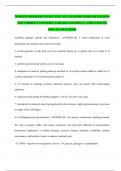-
1. Exam (elaborations) - Focus on nursing pharmacology 8th edition karch test bank
-
2. Exam (elaborations) - Nursing pharmacology final exam. the latest end semester exam revision questions and ...
-
3. Exam (elaborations) - Pediatric nursing pharmacology. all exam revision questions and correct answers (alre...
-
4. Exam (elaborations) - Pediatric nursing pharmacology. all exam revision questions and correct answers (alre...
-
5. Exam (elaborations) - Antibiotics nursing pharmacology. the latest exam revision questions and correct answ...
-
6. Exam (elaborations) - Cardiac meds nursing pharmacology exam revision. the latest exam revision questions a...
-
7. Exam (elaborations) - Chapter 54 nursing pharmacology. exam revision questions and correct answers (already...
-
8. Exam (elaborations) - Exam 1 - nursing pharmacology. the latest exam revision questions and correct answers...
-
9. Exam (elaborations) - Focus nursing pharmacology chapter 32. the latest exam revision questions and correct...
-
10. Exam (elaborations) - Focus nursing pharmacology chapter 33 prep. exam revision questions and correct answe...
-
11. Exam (elaborations) - Fundamentals of nursing pharmacology exam revision questions and correct answers (alr...
-
12. Exam (elaborations) - Fundamentals of nursing pharmacology. all pharmacology exam revision questions and co...
-
13. Exam (elaborations) - Introduction to nursing pharmacology quick revision guide for 2024. sample exam revis...
-
14. Exam (elaborations) - Introduction to nursing pharmacology revision questions. mid-term revision questions ...
-
15. Exam (elaborations) - Introduction to nursing pharmacology revision questions. all exam revision questions ...
-
16. Exam (elaborations) - Introduction to nursing pharmacology. top pharmacology exam revision questions and co...
-
17. Exam (elaborations) - Introduction to nursing pharmacology. exam revision questions and correct answers (al...
-
18. Exam (elaborations) - Maternity nursing pharmacology. exam revision questions and correct answers (already ...
-
19. Exam (elaborations) - Nursing pharmacology (drugs). the latest drug pharmacology exam revision questions an...
-
20. Exam (elaborations) - Nursing pharmacology—cardiac. all cardiac exam revision questions and correct answe...
-
21. Exam (elaborations) - Nursing pharmacology - exam 1. nursing pharmacology exam revision questions and corre...
-
22. Exam (elaborations) - Nursing pharmacology. practice case scenario exam questions with correct answers. bes...
-
23. Exam (elaborations) - Nursing pharmacology.
-
24. Exam (elaborations) - Nursing pharmacology 2. all exam revision questions and correct answers (already grad...
-
25. Exam (elaborations) - Nursing pharmacology 220. the latest exam revision questions and correct answers (alr...
-
26. Exam (elaborations) - Nursing pharmacology abbreviation samples. 2024 revision guide for nursing.
-
27. Exam (elaborations) - Nursing pharmacology abbreviations. revision practice abbreviations for pharmacology....
-
28. Exam (elaborations) - Nursing pharmacology all exam revision questions and correct answers (already graded ...
-
29. Exam (elaborations) - Nursing pharmacology all exam revision questions and correct answers (already graded ...
-
30. Exam (elaborations) - Nursing pharmacology all exam revision questions and correct answers (already graded ...
-
31. Exam (elaborations) - Nursing pharmacology all revision questions and correct answers (graded 100%) (2024 u...
-
32. Exam (elaborations) - Nursing pharmacology anti-infective drugs. the latest exam revision questions and cor...
-
33. Exam (elaborations) - Nursing pharmacology anticoagulants. exam revision questions and correct answers (alr...
-
34. Exam (elaborations) - Nursing pharmacology- cardiac drugs. the latest exam revision questions and correct a...
-
35. Exam (elaborations) - Nursing pharmacology diabetes medications. the latest exam revision questions and cor...
-
36. Exam (elaborations) - Nursing pharmacology: diabetes. exam revision questions and correct answers (already ...
-
37. Exam (elaborations) - Nursing pharmacology exam. all exam revision questions and correct answers (already g...
-
38. Exam (elaborations) - Nursing pharmacology final exam. sample exam revision practice questions with correct...
-
39. Exam (elaborations) - Nursing pharmacology final. final exam revision questions and correct answers (alread...
-
40. Exam (elaborations) - Nursing pharmacology fundamentals. exam revision questions and correct answers (alrea...
-
41. Exam (elaborations) - Nursing pharmacology sample exam revision practice questions with correct answers (20...
-
42. Exam (elaborations) - Nursing pharmacology hypertension. sample hypertension pharmacology exam revision pra...
-
43. Exam (elaborations) - Nursing pharmacology opioids. sample exam revision practice questions for opioids pha...
-
44. Exam (elaborations) - Nursing pharmacology: respiratory drugs test. 53 revision questions with correct answ...
-
45. Exam (elaborations) - Nursing pharmacology respiratory. exam revision questions and correct answers (alread...
-
46. Exam (elaborations) - Nursing pharmacology review. the latest exam revision questions and correct answers (...
-
47. Exam (elaborations) - Nursing pharmacology revision. all exam revision questions and correct answers (alrea...
-
48. Exam (elaborations) - Nursing pharmacology semester 1. end semester exam revision questions and correct ans...
-
49. Exam (elaborations) - Nursing pharmacology test all exam revision questions and correct answers (already gr...
-
50. Exam (elaborations) - Nursing pharmacology test. sample exam revision questions and correct answers (alread...
-
51. Exam (elaborations) - Nursing pharmacology the latest exam erevision questions and correct answers. (alread...
-
52. Exam (elaborations) - Nursing pharmacology (drugs) all exam revision questions and correct answers (already...
-
53. Exam (elaborations) - Aminoglycosides - nursing pharmacology. sample exam revision practice questions with ...
-
Show more




